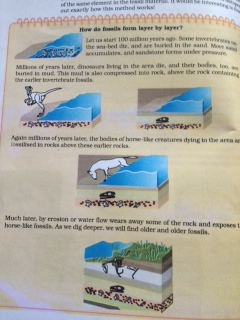4 Unscramble the text
In this strategy, students work to logically reorder some information. The scrambled information can be in the form of pictures, words, sentences or instructions. This is a more complex active reading activity. It requires more preparation from the teacher. It also is more demanding for the student, because the student has to think about both the meaning of the information and also the correct sequencing of it. It is a two-stage thinking process for the student.
Activity 3: Unscrambling the text to learn about fossil formation
This is an activity for you to plan and then do with your class.
Figure 2 is from the Class X textbook. It uses a series of pictures and associated text sections to show how fossils were created and how they can now be found. It is a good resource for an unscrambling activity.

There are two basic ways in which this resource can be used to create an unscrambling activity, one where the text can be unscrambled and one where the pictures can be unscrambled. A third complex version would be unscrambling the text and the pictures at the same time. If you don’t have access to a photocopier, the easiest version to plan for is that of unscrambling the text. You could ask your students to close their textbooks and write the sentences that need to be ordered on the blackboard (see Resource 3).
Test your plan with a colleague and adjust it for any feedback received. Use your plan with your Class X students when you are next teaching Chapter 9. This approach could also be used effectively with an experimental method. Write the steps in a random order and ask your students to put them in the correct order.
How did your students react to the activity? What did it tell you about their understanding of the formation of fossils? Do you need to discuss these ideas again?
It would be best not to break up the text into individual sentences as this would provide too complex an unscrambling activity for most students.
3 Complete the diagram
